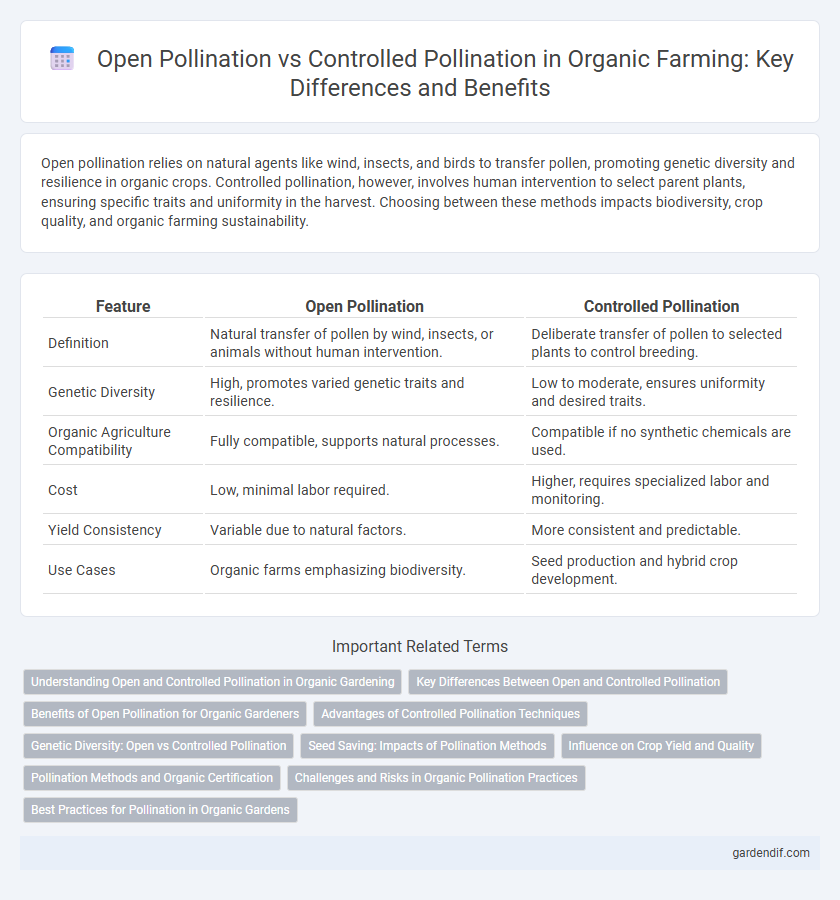
Open pollination vs Controlled pollination Illustration
Open pollination relies on natural agents like wind, insects, and birds to transfer pollen, promoting genetic diversity and resilience in organic crops. Controlled pollination, however, involves human intervention to select parent plants, ensuring specific traits and uniformity in the harvest. Choosing between these methods impacts biodiversity, crop quality, and organic farming sustainability.
Table of Comparison
| Feature | Open Pollination | Controlled Pollination |
|---|---|---|
| Definition | Natural transfer of pollen by wind, insects, or animals without human intervention. | Deliberate transfer of pollen to selected plants to control breeding. |
| Genetic Diversity | High, promotes varied genetic traits and resilience. | Low to moderate, ensures uniformity and desired traits. |
| Organic Agriculture Compatibility | Fully compatible, supports natural processes. | Compatible if no synthetic chemicals are used. |
| Cost | Low, minimal labor required. | Higher, requires specialized labor and monitoring. |
| Yield Consistency | Variable due to natural factors. | More consistent and predictable. |
| Use Cases | Organic farms emphasizing biodiversity. | Seed production and hybrid crop development. |
Understanding Open and Controlled Pollination in Organic Gardening
Open pollination in organic gardening relies on natural agents such as bees, wind, and insects to transfer pollen, promoting genetic diversity and resilience in crops. Controlled pollination involves deliberately selecting parent plants and manually transferring pollen to ensure specific traits, uniformity, and improved crop quality. Understanding these pollination methods enhances seed saving practices and supports the integrity of organic cultivation systems.
Key Differences Between Open and Controlled Pollination
Open pollination relies on natural agents such as wind, insects, and birds to transfer pollen, promoting genetic diversity and adaptability in crops. Controlled pollination involves deliberate human intervention to transfer pollen between selected plants, ensuring specific traits and hybrid vigor are maintained. This method enhances uniformity and predictability in seed production, crucial for organic seed certification and breeding programs.
Benefits of Open Pollination for Organic Gardeners
Open pollination promotes genetic diversity and resilience in organic gardens by allowing plants to naturally cross-pollinate, resulting in stronger and more adaptable offspring. This method supports sustainable seed saving, preserving heirloom varieties and reducing dependency on commercial seed sources. Organic gardeners benefit from open pollination due to its compatibility with natural ecosystems, enhancing pollinator health and biodiversity.
Advantages of Controlled Pollination Techniques
Controlled pollination techniques ensure precise genetic selection, enhancing crop uniformity and yield quality. They minimize cross-contamination risks, preserving the purity of organic seed lines. This targeted approach supports sustainable farming by optimizing desired traits such as disease resistance and drought tolerance.
Genetic Diversity: Open vs Controlled Pollination
Open pollination promotes genetic diversity by allowing natural cross-pollination among diverse plant varieties, resulting in resilient and adaptable crops. Controlled pollination restricts gene flow by selectively mating specific plants, preserving desired traits but reducing genetic variability. Greater genetic diversity from open pollination enhances disease resistance and environmental adaptability in organic farming systems.
Seed Saving: Impacts of Pollination Methods
Open pollination promotes genetic diversity by allowing plants to cross-pollinate naturally, which enhances seed saving by preserving resilience traits in organic crops. Controlled pollination, including hand pollination and isolation techniques, ensures specific trait inheritance but may reduce genetic variation essential for adapting to environmental stressors. Effective seed saving strategies in organic farming balance these methods to maintain crop health, improve yield stability, and protect heirloom varieties.
Influence on Crop Yield and Quality
Open pollination promotes genetic diversity, enhancing crop resilience and adaptability, which often leads to steady yields and robust plant health. Controlled pollination allows precise selection of traits, improving uniformity and quality, thereby increasing crop yield consistency and desired characteristics such as size, taste, and nutrient content. Both methods influence crop productivity, with controlled pollination optimizing specific qualities, while open pollination supports long-term sustainability and ecological balance.
Pollination Methods and Organic Certification
Open pollination relies on natural pollinators such as bees, wind, and insects, ensuring genetic diversity and resilience in organic crops. Controlled pollination involves manual or mechanical transfer of pollen, allowing precise cultivar development and preventing cross-contamination, which is crucial for maintaining organic certification standards. Organic certification standards prioritize natural pollination methods but permit controlled pollination when it supports biodiversity and excludes synthetic inputs.
Challenges and Risks in Organic Pollination Practices
Open pollination in organic farming faces challenges such as genetic unpredictability and increased susceptibility to cross-contamination from nearby non-organic crops, leading to compromised seed purity. Controlled pollination mitigates these risks by ensuring seed lineage integrity but demands higher labor input and expertise to manage pollinator behavior effectively. Both methods risk pest and disease transmission; however, organic practices limit chemical interventions, intensifying reliance on natural pest resistance and robust crop management.
Best Practices for Pollination in Organic Gardens
Open pollination encourages genetic diversity by allowing natural pollinators like bees and butterflies to transfer pollen freely among plants, enhancing resilience and fruit quality in organic gardens. Controlled pollination involves manually transferring pollen to ensure specific plant traits, which helps maintain purity and consistency in seed production while supporting organic certification standards. Best practices include planting diverse pollinator-friendly species, avoiding synthetic chemicals, and timing manual pollination during peak flower receptivity to maximize pollination success.
Open pollination vs Controlled pollination Infographic

 gardendif.com
gardendif.com